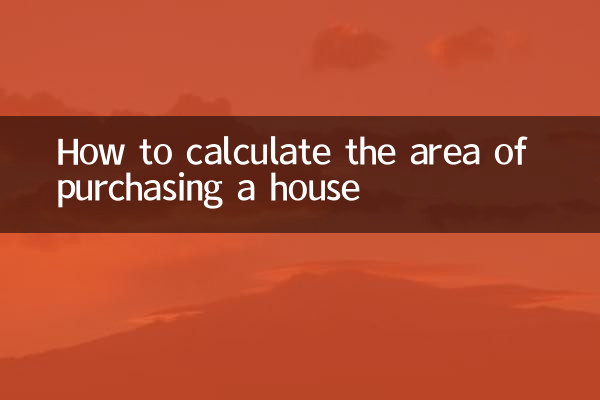How to calculate the area of purchasing a house
In the process of buying a house, the calculation method of area is directly related to the total price of the house and the actual use experience. However, many home buyers are confused by concepts such as "construction area", "unit area" and "shared area". This article will combine the hot topics and hot content on the Internet in the past 10 days to provide you with a detailed analysis of the calculation method of house purchase area and provide structured data for reference.
1. Common classifications of house purchase area

House purchase area is usually divided into the following categories:
| area type | definition | Calculation formula |
|---|---|---|
| Building area | Including the total area of the apartment and the shared area | Building area = apartment area + common area |
| Inner area | The actual usable area inside the house | Area inside the suite = usable area within the suite + wall area inside the suite + balcony area |
| Pool area | The area of public areas (such as elevators, corridors, etc.) allocated to each household | Shared area = building area × shared coefficient |
2. Controversies and hot spots about the area of public pools
Recently, the pool area has become a hot topic, with many netizens questioning its rationality and transparency. The following are the focus of discussions on the Internet in the past 10 days:
| Disputed points | Netizens’ opinions | Expert advice |
|---|---|---|
| The share ratio is too high | In some properties, the shared area accounts for more than 30%, and the actual housing acquisition rate is low. | Before buying a house, you need to clarify the share coefficient and compare different properties. |
| The calculation of public shares is not transparent | The developer has not disclosed the specific division of the public stall area in detail. | Ask the developer to provide details of the shared area |
| Public fees are charged repeatedly | Property fees are charged based on the building area, including the shared portion. | Promote the billing model based on the area within the suite |
3. How to avoid area calculation traps?
Home buyers should pay attention to the following when calculating area:
1.Verify surveying and mapping reports: The developer is required to provide an area surveying and mapping report from an authoritative organization to check whether the area within the condominium and the shared area are consistent with the contract.
2.Pay attention to the sharing coefficient: The sharing coefficients of different building types vary greatly. For example, the share factor for high-rise residential buildings is usually 20%-30%, while for multi-storey residential buildings it may be only 10%-15%.
3.Distinguish "gift area": Some developers will advertise "free balconies or bay windows", but these areas may have been included in the apartment area or shared area, so you need to check carefully.
4. Comparison of calculation of housing purchase area in different cities
The following is a comparison of recent calculation methods for home purchase area in popular cities:
| city | Mainstream pricing method | Sharing coefficient range | Remarks |
|---|---|---|---|
| Beijing | Priced based on building area | 20%-25% | Some luxury properties share over 30% share |
| Shanghai | Priced based on the area within the unit (for some properties) | 15%-22% | Pilot program to cancel public pool areas |
| Guangzhou | Priced based on building area | 18%-28% | Developers need to publish details of public stalls |
| Chongqing | Priced based on the area within the suite | Not applicable | The only city in the country that mandates in-package pricing |
5. Legal Basis for Calculation of House Purchase Area
According to the "Measures for the Administration of Sales of Commercial Housing" and the "Specifications for Calculation of Building Area of Construction Projects", the calculation of the area of purchased houses must comply with the following regulations:
1. The developer should clearly indicate the building area, apartment area and shared area in the contract.
2. When the absolute value of the area error ratio exceeds 3%, the home buyer has the right to check out or request compensation.
3. The calculation of the shared area must comply with national standards and shall not be expanded at will.
Conclusion
The calculation of the area of purchasing a house involves professional knowledge. Consumers need to understand the relevant rules in advance and carefully check the data before signing a contract. Recently, many places have begun to pilot the "price based on the area within the unit" model, which may become a trend in the future. It is recommended that home buyers pay more attention to policy developments and protect their own rights and interests.

check the details

check the details